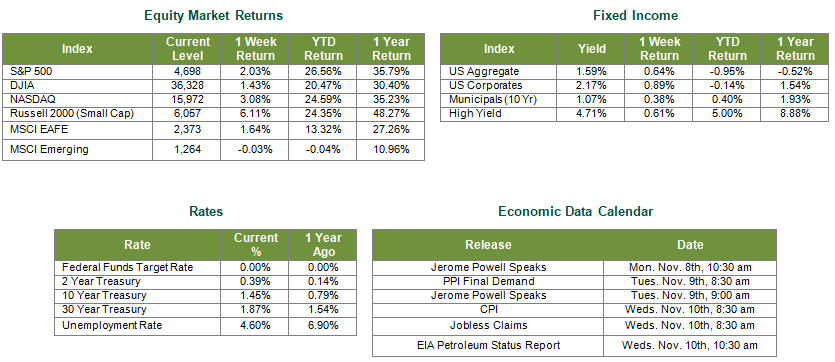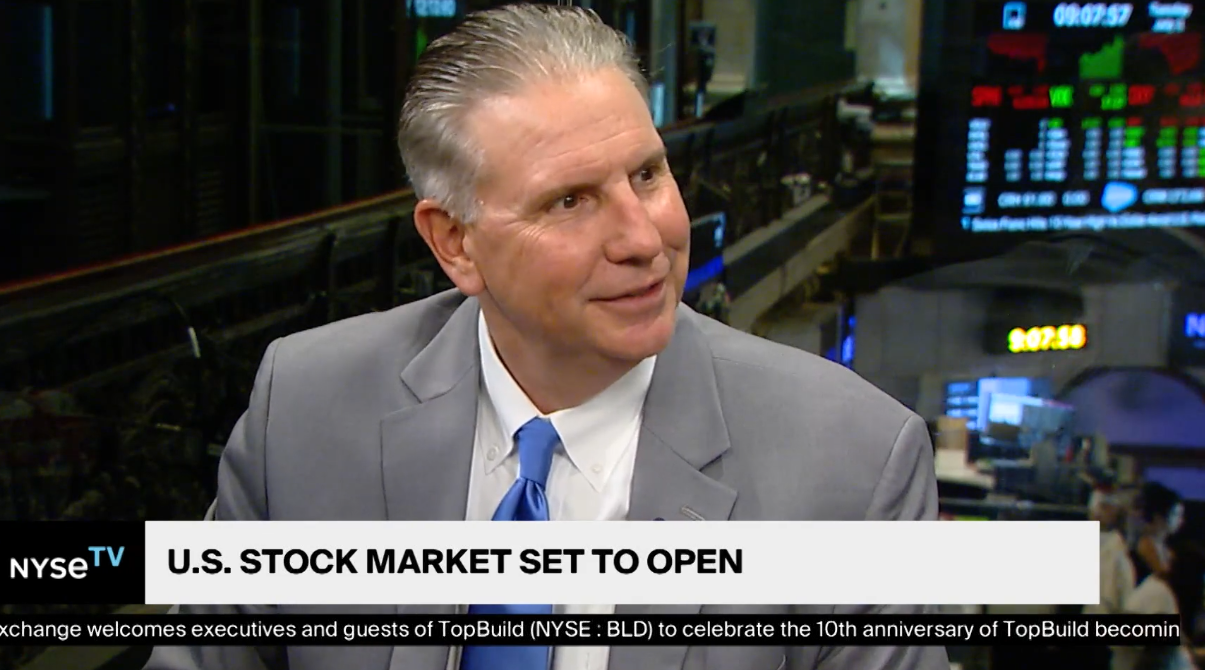
Last Week’s Markets in Review: Tapering Begins

U.S. markets were booming last week as the S&P 500 Index notched an all-time high for the seventh consecutive day on Friday and a fifth straight weekly advance. The S&P 500 closed the week at a level of 4,698, representing a gain of 2.03%, while the Russell Midcap Index moved 1.98% higher. Meanwhile, the Russell 2000 Index, a measure of the Nation’s smallest publicly traded firms, was the overall weekly winner returning 6.11%. International equity performance was mixed as developed and emerging markets returned 1.64% and -0.03%, respectively. Finally, the 10-year U.S. Treasury yield moved 10 basis points lower over the week, closing at 1.45% on Friday.
The November meeting of the Federal Open Market Committee was in full focus last Wednesday. Market participants were expecting material news regarding the asset purchase program implemented to help curb the economic impact of COVID-19, and potential indications of the Fed’s future path of interest rates. Before we review the outtakes from the meeting, we will first point out that markets were not necessarily skittish leading up to the announcement. For example, the S&P 500 Index hit new all-time highs on Monday and Tuesday as the strong earnings-driven run continued.
Wednesday afternoon, the Federal Reserve (“Fed”) announced that the current $120 billion monthly asset purchase program would be reduced by $15 billion ($10 billion U.S. Treasury securities and $5 billion agency mortgage-backed securities) starting later this month. The pace would continue to be reduced by $15 billion in December and likely subsequent months, but the Fed is prepared to pivot if warranted based on changing economic data. Following that expected timeline, asset purchases are expected to end in June 2022. The committee also acknowledged that supply/demand imbalances have contributed to elevated levels of inflation but believe that the anticipated easing of supply constraints should support growth and reduce inflation. There is no new guidance on short-term interest rates, and the next scheduled FOMC meeting is December 14-16, at which point we will receive revised economic projections.
It appears that the Federal Reserve’s measured and transparent approach paid off as the S&P 500 again moved into record territory post-announcement. Yields did move higher before falling back down on Thursday and we did not get the jolt reaction that we saw back in 2013. Many will remember the 2013 “Taper Tantrum” when then Chairman Ben Bernanke tipped the Fed’s intentions to pare down asset purchases during an appearance before Congress. The S&P 500 dropped 5.5% peak to trough over the next month and the yield on the 10-year U.S. Treasury jumped 57% through the end of 2013.
It is very important to note that tapering is not tightening, and the jury is still out on when the Federal Funds target rate will be adjusted higher. However, the framework conveyed last week may give the Fed the flexibility to make a determination on tightening likely in the second half of next year. According to CME Group, the market-implied probability of a rate hike by the time tapering could end in June 2022 is about 50%, increasing to 80% and 90% in September and December, respectively. Remember, the Fed would prefer time between tapering and tightening and they hope that inflation will not put them in a position to have to raise rates too quickly and inhibit economic growth. Time will tell if tapering can help put a lid on inflation until the Fed deems it appropriate to increase rates. As it stands today, monetary policy remains extremely accommodative. This fact, along with strong aggregate demand, continued economic reopenings, and the eventual easing of labor issues and supply chain constraints, point to further upside potential in equity markets.
As always, we encourage investors to work with experienced financial professionals to help navigate the capital markets and build and manage the asset allocations within their portfolio strategies consistent with their objectives, timeframe, and tolerance for risk. Best wishes for the week ahead!
Sources for data in tables: Equity Market and Fixed Income returns are from JP Morgan as of 11/5/21. Rates and Economic Calendar Data from Bloomberg as of 11/5/21. International developed markets measured by the MSCI EAFE Index, emerging markets measured by the MSCI EM Index, U.S. Large Cap defined by the S&P 500. Sector performance is measured using the GICS methodology.
Disclosures: Past performance does not guarantee future results. We have taken this information from sources that we believe to be reliable and accurate. Hennion and Walsh cannot guarantee the accuracy of said information and cannot be held liable. You cannot invest directly in an index. Diversification can help mitigate the risk and volatility in your portfolio but does not ensure a profit or guarantee against a loss.
Diversification can help mitigate the risk and volatility in your portfolio but does not ensure a profit or guarantee against loss.
Investing in commodities is not suitable for all investors. Exposure to the commodities markets may subject an investment to greater share price volatility than an investment in traditional equity or debt securities. Investments in commodities may be affected by changes in overall market movements, commodity index volatility, changes in interest rates or factors affecting a particular industry or commodity.
Products that invest in commodities may employ more complex strategies which may expose investors to additional risks.
Investing in fixed income securities involves certain risks such as market risk if sold prior to maturity and credit risk especially if investing in high yield bonds, which have lower ratings and are subject to greater volatility. All fixed income investments may be worth less than the original cost upon redemption or maturity. Bond Prices fluctuate inversely to changes in interest rates. Therefore, a general rise in interest rates can result in the decline of the value of your investment.
Definitions
MSCI- EAFE: The Morgan Stanley Capital International Europe, Australasia and Far East Index, a free float-adjusted market capitalization index that is designed to measure developed-market equity performance, excluding the United States and Canada.
MSCI-Emerging Markets: The Morgan Stanley Capital International Emerging Market Index, is a free float-adjusted market capitalization index that is designed to measure the performance of global emerging markets of about 25 emerging economies.
Russell 3000: The Russell 3000 measures the performance of the 3000 largest US companies based on total market capitalization and represents about 98% of the investible US Equity market.
ML BOFA US Corp Mstr [Merill Lynch US Corporate Master]: The Merrill Lynch Corporate Master Market Index is a statistical composite tracking the performance of the entire US corporate bond market over time.
ML Muni Master [Merill Lynch US Corporate Master]: The Merrill Lynch Municipal Bond Master Index is a broad measure of the municipal fixed income market.
Investors cannot directly purchase any index.
LIBOR, London Interbank Offered Rate, is the rate of interest at which banks offer to lend money to one another in the wholesale money markets in London.
The Dow Jones Industrial Average is an unweighted index of 30 “blue-chip” industrial U.S. stocks.
The S&P Midcap 400 Index is a capitalization-weighted index measuring the performance of the mid-range sector of the U.S. stock market, and represents approximately 7% of the total market value of U.S. equities. Companies in the Index fall between S&P 500 Index and the S&P SmallCap 600 Index in size: between $1-4 billion.
DJ Equity REIT Index represents all publicly traded real estate investment trusts in the Dow Jones U.S. stock universe classified as Equity REITs according to the S&P Dow Jones Indices REIT Industry Classification Hierarchy. These companies are REITs that primarily own and operate income-producing real estate.



